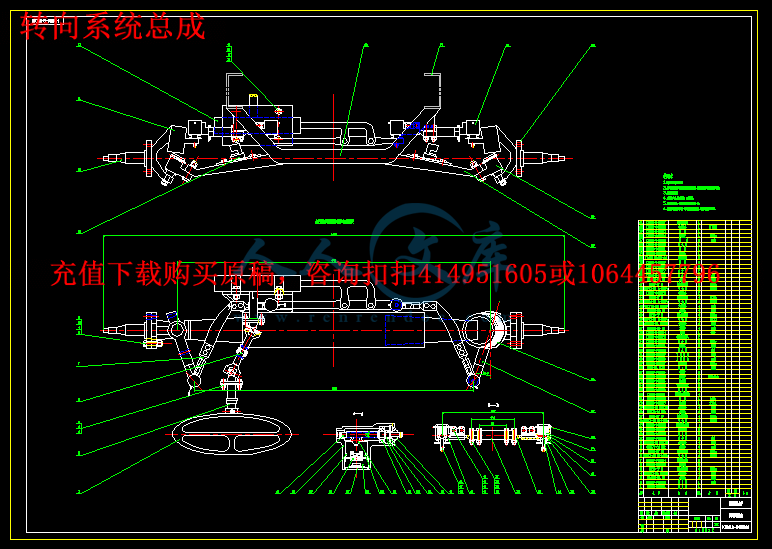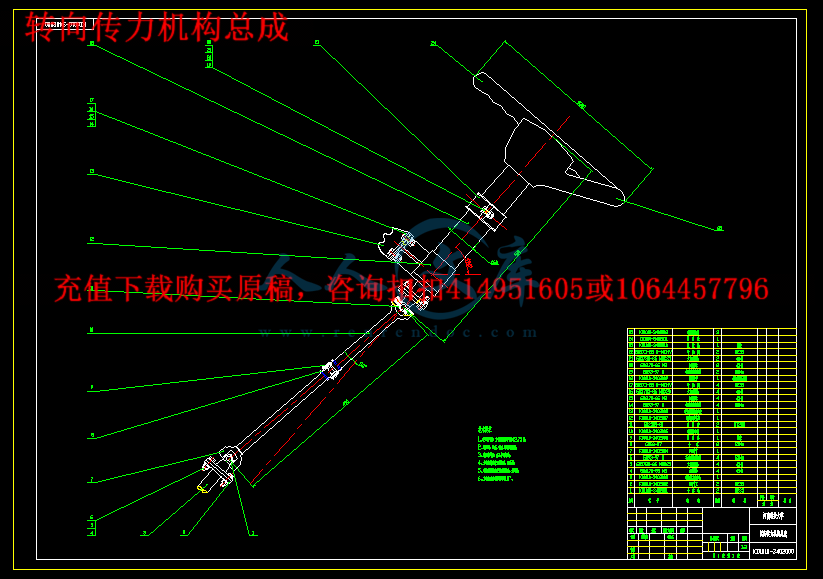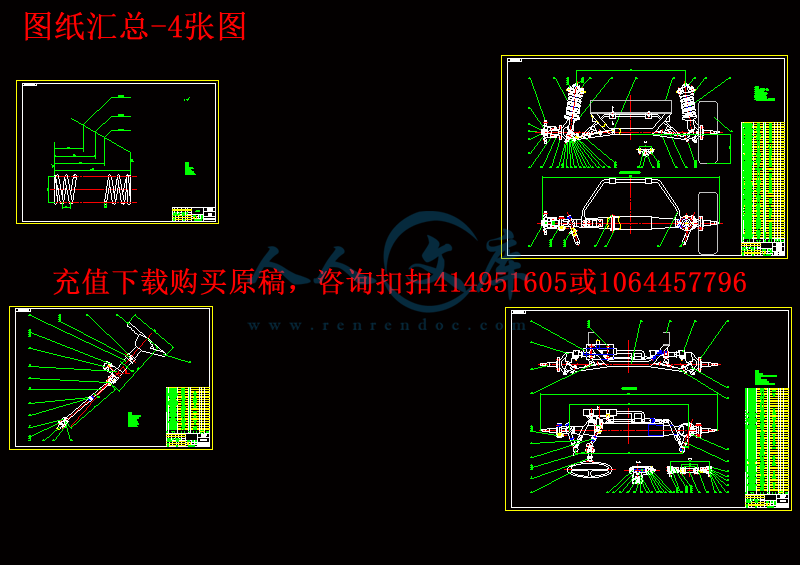4座微型客货两用车设计(前悬架、转向系设计)
摘 要
在这次毕业设计中,我主要负责转向系统及前悬架系统的设计。经过收集各类型的悬架的资料,实车观测,老师的指导。在研究了各类型的独立,非独立悬架系统之后,总结了其各自特点,认识到了各自优劣,分析对比之后,最终确定本车悬架系统:麦弗逊前独立悬架。
在前悬的设计中主要围绕麦弗逊独立悬架展开。前期的工作主要是收集相关资料,信息,在此过程中,其结构是研究的重点。计算主要集中在了弹性元件—普通圆形螺旋弹簧的各个重要参数。如,弹簧刚度,中径,弹簧钢丝直径等等。随后对这些数据进行了必要的校核。
最后对减振器和横向稳定器的结构以及它们在整个悬架系统中的作用进行了一些探讨。
转向系统设计内容主要包括转向系统形式的选择、转向器的选择、转向梯形的选择及其布置。
我们所设计的车型是小排量车,鉴于我国路面质量的逐步提高和作用于方向盘的作用力(144.865N-177.06N)不是很大,故在设计中考虑采用机械式转向系统。
由于齿轮齿条式转向器与其他的转向器相比,虽然其逆效率很高,但其具有结构简单、紧凑、壳体采用铝合金或者镁合金压铸而成,转向器质量比较小、传动效率高达90%以上,因此本设计选用齿轮齿条式转向器。
由于我们设计的车前悬比较短,发动机占有的空间相对来说很大,且由于转向系统转向梯形最小传动角和转向器的安装距离有很大的关系,综合以上因素我采用后置式转向梯形。
关键词:独立悬架,麦弗逊式,机械式转向系,齿轮齿条式转向器。
THE DESIGN OF THE FRONT SUSPENSION AND STEERING SYSTEM OF THE MINIATURE MOTORCAR TO CARRY PERSONS AND GOODS WITH 4 SEATS
ABSTRACT
In this graduation design, I am responsible for automobile's steering system and the front suspension system design of the miniature motorcar to carry persons and goods with 4 seats mainly..In weeks ,I work hard to get the more useful information to do my work better. With the helping of Mr Li and other teachers ,and observation on vehicle in laboratory .I got a conclusion : the front independent McPherson suspension is the best form for this automotive .
All focus on elastic part .Because elastic is the most important part in them .And I have got some important data for my design work . If I can’t get those data ,I could not do my work in the following days .I get many data ,but for front independent McPherson suspension the main thing is about spring , such as spring rate ,middle diameter ,spring wire diameter and so on .spring rate is the most important data for my independent suspension ,it do many influence about suspension.
In the last I discussion shock absorber and anti-roll-bar a little,and involve the basic of them and the important usefully in modern car’s suspension.
Because the motortcar we design is a kind of small output volume, seeing that the gradual improvement of the road surface quality of our country and effort of acting on the steering wheel are not very large, so I choose the manual steering system.
Compared with others steering gear, though the negative efficiency of the rack and pinion steering gear is high, but it have of simple structure, compactness, shell adopt aluminum alloy or magnesium alloy die casting, the weight of the rack and pinion steering system is much smaller than others, transmission efficiency is up to more than 90%, so in this design I choose the rack and pinion steering system.
Because the front overhang of the car is very short and the engine occupied comparatively very big space, what is more, the minimum transmission angle of the Ackerman steering has a very close relation with installation distance of the steering gear, so I choose fit the Ackerman steering in the back of the car conceding all those factor above.
KEY WORDS : independent suspension,MacPherson,the manual steering system, the rack and pinion steering gear
目 录
第一章 前言..............................................1
第二章 汽车转向系设计..................................3
§2.1 概述...............................................3
§2.2 转向系的设计要求.................................7
第三章 转向器、转向传动操纵机构、转向传动机构.........9
§3.1 转向器.............................................9
§3.2 转向操纵机构......................................9
§3.3 转向传动机构和布置..............................10
第四章转向系有关的计算及校核........................11
§4.1 转向系主要性能参数..............................11
§4.2 转向器有关参数的设计计算及校核................14
§4.3 转向传动机构的设计计算与强度校核..............15
第五章 悬架结构方案分析...............................19
§5.1 悬架的功用.......................................19
§5.2 悬架系统的组成...................................19
§5.3 悬架的类型及其特点..............................21
第六章 前悬架的设计计算...............................25
§6.1 弹簧形式的选择...................................25
§6.2 弹簧参数的计算...................................25
§6.3 弹簧的校验.......................................27
第七章 减震器的结构原理及其功用......................28
§7.1 减震器的作用.....................................28
§7.2 减震器的结构.....................................29
§7.3 减震器的工作原理................................29
§7.4 减振器主要尺寸的确定............................29
第八章 横向稳定器的作用...............................32
第九章 结论.............................................34
参考文献................................................35
致谢.................................................... 36
第一章 前 言
前段时间,一些地方针对小排量经济型汽车、柴油汽车等废气和噪声污染大、安全性不高、外形不够美观等问题,在道路交通管理以及出租汽车车辆更新中,制定出台了一些限制性规定。目前这些规定已不适应我国国情和建设节约型社会的要求。近年来,随着国际市场上油价的不断上涨,汽车的使用成本大幅度提高,消费者普遍感到现在汽车不是买不起而是用不起。因此,该因素客观上对原来小排量汽车的限制给以巨大的冲击最终促使国家发改委取消了对小排量汽车的限制。由于汽车工业科技水平的不断提高,节能环保型小排量汽车在安全性、动力性和外观等方面都有了很大改善,同时其燃油消耗少、尾气排放低、外形尺寸小、道路和车位占用面积少等优点也日益突出。但在发展节能环保型小排量汽车方面,我国目前缺乏应有的鼓励支持政策,一部分地区甚至还没有真正意义上解除对小排量汽车的限制性规定。
目前,节能环保型小排量汽车已成为汽车发展的主流和消费者关注的热点。美国、日本、欧洲等发达国家和地区节能环保型小排量汽车比例已占70%以上。我国节能环保型小排量汽车正日益受到消费者的喜爱,增长迅速,但比例仍然偏低。积极发展节能环保型小排量汽车,符合我国能源供给实际和大众消费水平,是建设节约型社会的重要措施,不仅有利于缓解能源紧张状况,保护环境,而且有利于培育我国汽车工业自主品牌,提高国际竞争力,对于促进汽车产业可持续发展,落实国家能源发展战略,加快建设资源节约型、环境友好型社会,具有重要意义。
国家依据《产业结构调整指导目录》指导意见,采取积极鼓励低油耗、低排放、小排量、小型化、高动力性汽车的生产和投资的政策。加大节能环保型小排量汽车及其先进发动机(汽油机升功率大于50KW,柴油机升功率大于40KW)技术研究开发和产业化的支持力度。鼓励开发、生产柴油轿车和微型车。由于我国刚刚解除对小排量汽车的限制,我们与传统汽车巨头在这一领域内的差距还不是甚大,因此更加有利于我们民族汽车行业抓住有利时机来发展自己,缩小与国际汽车巨头的差距。考虑到这种因素我们决定来设计一款小排量汽车。
小排量汽车在我国由于以前的限制政策,目前阶段是其黄金发展时期。因此,能否抓住该有利时机,也将决定我们能否与国际汽车巨头同台竞技。






 川公网安备: 51019002004831号
川公网安备: 51019002004831号